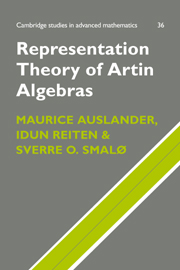Book contents
- Frontmatter
- Contents
- Introduction
- I Artin rings
- II Artin algebras
- III Examples of algebras and modules
- IV The transpose and the dual
- V Almost split sequences
- VI Finite representation type
- VII The Auslander–Reiten-quiver
- VIII Hereditary algebras
- IX Short chains and cycles
- X Stable equivalence
- XI Modules determining morphisms
- Notation
- Conjectures
- Open problems
- Bibliography
- Relevant conference proceedings
- Index
VI - Finite representation type
Published online by Cambridge University Press: 11 May 2010
- Frontmatter
- Contents
- Introduction
- I Artin rings
- II Artin algebras
- III Examples of algebras and modules
- IV The transpose and the dual
- V Almost split sequences
- VI Finite representation type
- VII The Auslander–Reiten-quiver
- VIII Hereditary algebras
- IX Short chains and cycles
- X Stable equivalence
- XI Modules determining morphisms
- Notation
- Conjectures
- Open problems
- Bibliography
- Relevant conference proceedings
- Index
Summary
The artin algebras of finite representation type are in some sense the simplest kinds of artin algebras, and a lot of effort has been put into understanding and classifying various classes of algebras of finite representation type. Often these algebras serve as a test case and inspiration for what might be true more generally. For example existence of almost split sequences was first proved in this context.
This chapter is devoted to studying algebras of finite representation type. We start by giving a criterion for finite type in terms of irreducible morphisms, which we apply to describe all indecomposable modules over Nakayama algebras. Using the special features of group algebras developed in Chapter III, we describe which group algebras over fields are of finite representation type. A criterion for finite representation type is also given in terms of generators and relations for the Grothendieck group of artin algebras. The chapter ends with a discussion of the endomorphism algebra of a Λ-module M containing all indecomposable modules as a summand when Λ is of finite representation type. These algebras are called Auslander algebras.
A criterion for finite representation type
In this section we use almost split morphisms to give a criterion for an artin algebra Λ to be of finite representation type. Using this criterion we show that Λ is of finite type if there is a bound on the length of the indecomposable Λ-modules.
Denote as before by ind Λ a fixed full subcategory of mod Λ whose objects consist of a complete set of nonisomorphic indecomposable Λ-modules We first define an equivalence relation on the objects of ind Λ.
- Type
- Chapter
- Information
- Representation Theory of Artin Algebras , pp. 191 - 223Publisher: Cambridge University PressPrint publication year: 1995



